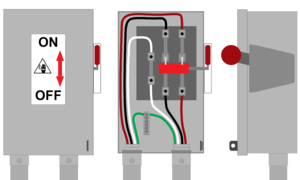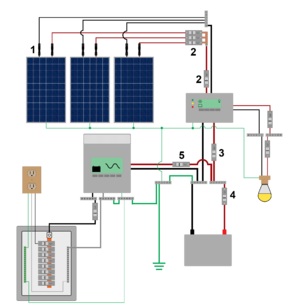Difference between revisions of "Disconnect"
m (Alex moved page Disconnects to Disconnect) |
|||
| (2 intermediate revisions by the same user not shown) | |||
| Line 1: | Line 1: | ||
[[Category:Protection devices and disconnects]] | [[Category:Protection devices and disconnects]] | ||
| − | [[File:Disconnect201022.png|thumb|right|'''An example of a | + | <languages /> |
| − | + | <translate> | |
| + | <!--T:1--> | ||
| + | [[File:Disconnect201022.png|thumb|right|'''An example of a manual disconnect switch.'''<br />The red handle moves the red cylinder in the center to connect and disconnect the line (top) and load (bottom) terminals.]] | ||
| + | <!--T:2--> | ||
| + | A disconnect enables a circuit to be disconnected or isolated from the rest of an electrical system. Disconnects are vital for safety and security as they allow different components in the system to be isolated in order to perform maintenance or service. Manual disconnects, like in the image, come in countless different sizes and configurations, including custom-built configurations. Although they are not often used in small-scale off-grid installations as most disconnecting needs can be met with breakers, fuse holders, or [[Special:MyLanguage/Module connectors|module connectors]] which are cheaper and simpler. A traditional disconnect must be rated for the proper current (AC or DC), maximum voltage and maximum current of the circuit. Disconnects can also be found that incorporate fuses for applications that require a traditional disconnect and overcurrent protection. | ||
| + | |||
| + | <!--T:3--> | ||
The appropriate type of disconnect for a circuit depends upon the type of circuit - there are two different types of disconnects that are required in an off-grid PV system. | The appropriate type of disconnect for a circuit depends upon the type of circuit - there are two different types of disconnects that are required in an off-grid PV system. | ||
| − | ==Disconnects in a stand-alone PV system== | + | ==Disconnects in a stand-alone PV system== <!--T:4--> |
| − | Each off-grid PV system will vary in terms of the necessary disconnect needs both due to design and local requirements. The diagram at right depicts a hypothetical stand-alone system with DC lighting and an inverter for loads. It depicts disconnects that are commonly required in an off-grid system | + | |
| − | ====Power source disconnects==== | + | <!--T:5--> |
| − | [[File:Disconnectslabeled.png|thumb|right|Wiring diagram of a stand-alone PV system with a charge controller with DC lighting control and an inverter for AC loads. All required | + | Each off-grid PV system will vary in terms of the necessary disconnect needs both due to design and local requirements. The diagram at right depicts a hypothetical stand-alone system with DC lighting and an inverter for loads. It depicts disconnects that are commonly required in an off-grid system. Simpler systems will often not require as many as in the image and more complex systems often require additional disconnects. |
| + | |||
| + | ====Power source disconnects==== <!--T:6--> | ||
| + | |||
| + | <!--T:7--> | ||
| + | [[File:Disconnectslabeled.png|thumb|right|Wiring diagram of a stand-alone PV system with a charge controller with DC lighting control and an inverter for AC loads. All required disconnects are identified.]] | ||
| + | |||
| + | <!--T:8--> | ||
Power source disconnects enable the isolation of any potential power source, including while under load (while current is flowing) in case of emergency. In an off-grid PV system there are three power sources that meet this requirement: | Power source disconnects enable the isolation of any potential power source, including while under load (while current is flowing) in case of emergency. In an off-grid PV system there are three power sources that meet this requirement: | ||
| − | |||
| − | |||
| − | |||
| − | If a system incorporates a generator then it will also require a separate disconnect. For off-grid PV systems, breakers are typically used as power source disconnects as they can fulfill the role of an OCPD at the same time | + | <!--T:9--> |
| + | *The [[Special:MyLanguage/PV module|PV source]] (disconnect #2 in the diagram). | ||
| + | *The [[Special:MyLanguage/Energy storage|energy storage system]] (disconnect #4 in the diagram). | ||
| + | *The [[Special:MyLanguage/Inverter|inverter]] (disconnect #5 in the diagram). | ||
| + | |||
| + | <!--T:10--> | ||
| + | If a system incorporates a generator then it will also require a separate disconnect. For off-grid PV systems, breakers are typically used as power source disconnects as they can fulfill the role of a disconnect and an OCPD at the same time. Any power source disconnect must be rated to disconnect a circuit with current flowing, therefore fuse holders or any type of connector cannot qualify as a power source disconnect as they cannot be opened under load. | ||
| − | ====Equipment disconnects==== | + | ====Equipment disconnects==== <!--T:11--> |
| + | |||
| + | <!--T:12--> | ||
All major components in a PV system that may require service or maintenance should have a disconnect that enables them to be isolated from these two potential power sources or any others, although for equipment that is not a power source, it is not necessary that an equipment disconnect be able to function under load. In a typical stand-alone system, there are three pieces of equipment that meet this requirement: | All major components in a PV system that may require service or maintenance should have a disconnect that enables them to be isolated from these two potential power sources or any others, although for equipment that is not a power source, it is not necessary that an equipment disconnect be able to function under load. In a typical stand-alone system, there are three pieces of equipment that meet this requirement: | ||
| + | |||
| + | <!--T:13--> | ||
*PV module equipment (disconnect #1 in the diagram). | *PV module equipment (disconnect #1 in the diagram). | ||
*Charge controller equipment (disconnect #3 in the diagram). | *Charge controller equipment (disconnect #3 in the diagram). | ||
*Inverter equipment (disconnect #5 in the diagram). | *Inverter equipment (disconnect #5 in the diagram). | ||
| − | Therefore, touch safe fuse holders and equipment connectors - like | + | Therefore, touch safe fuse holders and equipment connectors - like connectors on PV modules - can qualify as equipment disconnects. To be able to use equipment disconnects that are not designed to function under load, it is necessary to have a power source disconnect that can be used to stop any current from flowing before use. |
| + | |||
| + | ====Notes/references==== <!--T:14--> | ||
| + | |||
| + | </translate> | ||
Latest revision as of 06:54, 15 February 2021
A disconnect enables a circuit to be disconnected or isolated from the rest of an electrical system. Disconnects are vital for safety and security as they allow different components in the system to be isolated in order to perform maintenance or service. Manual disconnects, like in the image, come in countless different sizes and configurations, including custom-built configurations. Although they are not often used in small-scale off-grid installations as most disconnecting needs can be met with breakers, fuse holders, or module connectors which are cheaper and simpler. A traditional disconnect must be rated for the proper current (AC or DC), maximum voltage and maximum current of the circuit. Disconnects can also be found that incorporate fuses for applications that require a traditional disconnect and overcurrent protection.
The appropriate type of disconnect for a circuit depends upon the type of circuit - there are two different types of disconnects that are required in an off-grid PV system.
Contents
Disconnects in a stand-alone PV system
Each off-grid PV system will vary in terms of the necessary disconnect needs both due to design and local requirements. The diagram at right depicts a hypothetical stand-alone system with DC lighting and an inverter for loads. It depicts disconnects that are commonly required in an off-grid system. Simpler systems will often not require as many as in the image and more complex systems often require additional disconnects.
Power source disconnects
Power source disconnects enable the isolation of any potential power source, including while under load (while current is flowing) in case of emergency. In an off-grid PV system there are three power sources that meet this requirement:
- The PV source (disconnect #2 in the diagram).
- The energy storage system (disconnect #4 in the diagram).
- The inverter (disconnect #5 in the diagram).
If a system incorporates a generator then it will also require a separate disconnect. For off-grid PV systems, breakers are typically used as power source disconnects as they can fulfill the role of a disconnect and an OCPD at the same time. Any power source disconnect must be rated to disconnect a circuit with current flowing, therefore fuse holders or any type of connector cannot qualify as a power source disconnect as they cannot be opened under load.
Equipment disconnects
All major components in a PV system that may require service or maintenance should have a disconnect that enables them to be isolated from these two potential power sources or any others, although for equipment that is not a power source, it is not necessary that an equipment disconnect be able to function under load. In a typical stand-alone system, there are three pieces of equipment that meet this requirement:
- PV module equipment (disconnect #1 in the diagram).
- Charge controller equipment (disconnect #3 in the diagram).
- Inverter equipment (disconnect #5 in the diagram).
Therefore, touch safe fuse holders and equipment connectors - like connectors on PV modules - can qualify as equipment disconnects. To be able to use equipment disconnects that are not designed to function under load, it is necessary to have a power source disconnect that can be used to stop any current from flowing before use.

